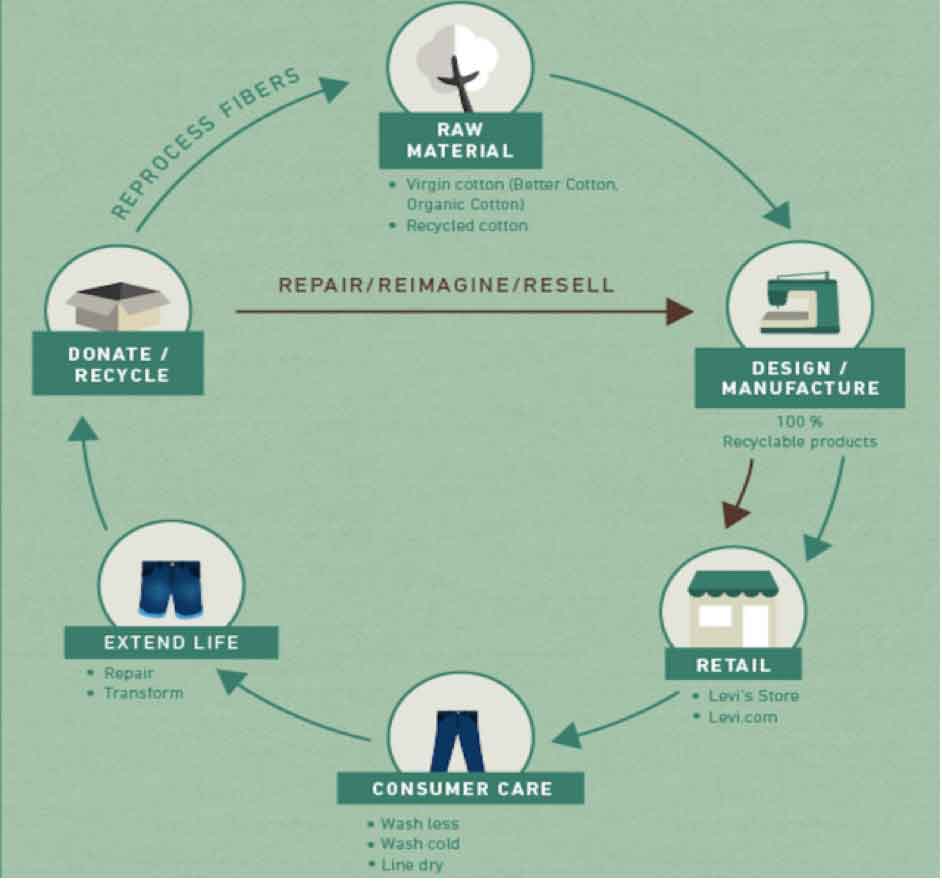Sustainability and recycling are the buzz word today, and all stake holders in the apparel supply chain right from manufacturers to consumers are working toward this cause. To implement the same in denim industry, research and development is undergoing to make denim recycling and manufacturing more sustainable.
To exemplify some of the changes implemented over the years are- elimination of nylon thread and rivets from jeans and making it compostable. Many researchers are working to use recycled denim to make new without any alteration in its quality. Positive initiatives by government includes solid waste management, reduction of load to landfill by reuse and recycling and laws and regulations for environmental protection. The highlighted points in this article include denim significance, manufacturing and landfill issues, the technologies involved in the reuse and recycling of denim, enlist some organizations globally which are involved in denim recycling and a forecast for future roadmap in terms of sustainability.
Some Fun Facts & Figures About Denim:
- Approximately 16,000,000 tons of textile waste are discarded in a year and all of which go in landfills, while only a minor share of this number actually goes for recycling.
- To grow enough amount of cotton to make one denim pair, water consumption is 946 litres.
- Jeans was invented for use by sailors and construction workers about 150 years ago and is a popular fashion staple till now.
- Only 225 pairs of denim can be made from one bale of cotton.
- The creator of the popular brand Levi’s, Levi Strauss never worn any jeans himself because of the mentality that jeans is an apparel for poor people.
- The president of America, George Bush decided in 2001, that nobody will wear Jeans in the Oval office.
- Before the artificial dyes became common, Indigo was imported from India to manufacture denim.
- 90% of zippers on denim is YKK.
- In 2001, George W. Bush decided that staff in the Oval Office were not allowed to wear jeans anymore
- The oldest pair of jeans to be discovered was found in 1998 down an old mine. According to the date, they were 115 years old.
- In 2001, George W. Bush decided that staff in the Oval Office were not allowed to wear jeans anymore.
Blue Jeans Go Green Program by Cotton Inc.:
The afterlife of denims is always blue. Used and old denims can be diverted from the landfill and given a new life by recycling it into many useful applications.
Success Stories:
- Till now, 81+ colleges and universities participated in the Cotton From Blue to Green program and collected 2,21,418 pieces of denim.
- In spring 2009, National Geographic Kids magazine partnered with the FROM BLUE TO GREEN.®denim drive /to set the Guinness World Record™ for “Most Items of Clothing Collected for Recycling” and the record was 33,088 number of denim.
- In fall 2009, the COTTON, FROM BLUE TO GREEN.® denim partnered with teen retailer Vanity, Inc., which has almost 200 stores nationwide. Vanity set the ambitious goal of collecting 100,000 pairs of jeans during their three-week promotional period and ended up surpassing it; the final tally was 105,192.
- Since the start of the COTTON. FROM BLUE TO GREEN.® denim drive in 2006, now renamed as “Blue Jeans Go Green”, the program has received a total of over 2,500,000 pieces of denim and notably, preventing 1230+ tons of denim from being sent to landfills.
- Till now, this program has produced 4,830,000+ sq ft of denim ultra-touch insulation.
- 500 pair of jeans are sufficient to completely insulate one home
- GAP, Wrangler, Levis, rag and bone, American eagle, Old navy, Stitch fix, Abercrombie & fitch are some of the leading brands associated with this initiative.
The denim received for recycling is returned to its natural, original fiber state, cotton, preparing it for the insulation process. The reprocessed cotton fiber is treated with a borate solution for fire retardency and mold/mildew resistance. Sheets of insulation are cut to size and prepared for packaging to be shipped and installed for use in residential homes and commercial buildings across the country.
Benefits of Ultratouch Denim insulation:
- Composed of 85% recycled cotton fibers
- Environmentally safe, non-itch insulation without carcinogenic warnings, formaldehyde or chemical irritants.
- Provides exceptional thermal performance
- Acoustically provides 30% better sound absorption than traditional fiberglass insulation.
- One of the only insulating products that contains an active mold/mildew inhibitor.
Now the big question comes, how to Recycle Denim?
a. Repurposing:
The straight forward way is to turn the old garments into useful items. For example, shorts for casual summer wear can be made from a frayed cuffs jeans. Alternatively, open the inseams of two pairs of jeans. Cut up one pair to make inserts of fabric and combine the two to make a skirt. Save elderly jeans in a variety of shades and colors and cut them into squares for quilting or strips for rug making.
b. Donation
Many charitable and nonprofit organizations operate thrift stores for fundraising purposes, giving your old jeans a new lease on life.
c. Fabric Recycling
According to 2010 figures from the Environmental Protection Agency, used fabrics made up more than 5% of solid waste in the United States. Of that total, only about 15% was recovered and recycled.
d. Composting
Although it’s not the first option that springs to mind for many people, composting is also a viable strategy for using your old denim. As most of the denim is made from 100% cotton. It can cut into thin strips and used for composting.
Initiatives By Retailers For Denim Recycling:
Many of the retailers have come up with denim recycling as corporate social responsibility. Few of them are listed below:
a. Levi Strauss & Co.
Levi Strauss has recently launched a $100,000 denim insulation fund to reuse unwanted denim while keeping it out of landfills. Denim is a staple in nearly everyone’s wardrobe, but it shouldn’t be a staple in our landfills, said Jill Nash, vice president of corporate affairs, Levi Strauss & Co. By encouraging our consumers to donate unwanted jeans and then promoting recycled denim as insulation in buildings, we can green our communities from the inside out and extend the lifecycle of every pair of jeans. (Source: Levi’Strauss.com)
And then there’s the challenge of getting people to think of recycling clothes the way they do other products. Also a 20% discount voucher is offered to customers as promotional scheme to encourage recycling.
b. Lee
Lee has launched ’re-denim project’, a unique initiative that allows you to donate your old denims and get a free denim curio, made from recycled denim. You can take your pick from a range of goodies such as ipad covers, pen holders or even bottle holders: all created by A Hundred Hands, a non-profit organization that cares for the environment and the underprivileged through recycled craft.
This drive is in keeping with Lee’s endeavor to be as mindful about sustainability as it is about fashion. The e-CREATE range of clothing available in Lee stores was a major step towards this goal and featured clothing made using lesser amounts of water in the creation process, products made from pure organic cotton and even products from plastic trash.
c. Lifestyle brand Guess
In Aug 2016, Denim lifestyle brand Guess has partnered with Cotton Inc’s ‘Blue Jeans Go Green’ program with the launch of a ‘Fall Denim Recycling’ campaign taking place in over 160 Guess stores in the US and Canada. The denim jeans brand will mount a digital and online marketing campaign and also in its stores, which will encourage its customers to recycle their denim at any local Guess store.
CEO at Guess Victor Herrero said, “Guess Fall Denim Recycling program will provide our customers and the community with the resources to make a positive change.” “By understanding and prioritising our social and environmental impacts, we will create a stronger brand that will continue to be a worldwide leader, shaping the fashion industry,” he added.
d. Lindex
In Nov 2016, Lindex has debuted a new range of denim jeans for women and kids named ‘Even Better Denim’, containing post-consumer recycled cotton. The collection has more sustainable cotton and post-consumer recycled cotton and the styles represent a new step in the retailer’s journey towards even more sustainable denim and closing the textile production loop. The lines are also dyed in a cleaner and more sustainable process that is more resource efficient, while the zippers, buttons, labels and other accessories are the most sustainable alternatives that Lindex has found in the market. “Old garments that normally would have gone to waste have now become part of our new ‘Even Better Denim’ styles,” Sara Winroth, sustainability manager at Lindex. “That way we reduce the use of virgin material, saving water and energy in production.”
Applications of Recycled Denim:
a. Denims for Home insulation:
As stated above in Blue Jeans go green program for manufacturing of insulation for homes.
b. For new cars:
Old denims now have found their way into the next generation Ford Focus cars. Recycled cotton materials from used blue jeans are used as a part of carpet backing and sound absorption in Ford cars. Post consumer cotton used in a car is obtained from approximately two pair of jeans. Recycled content is a way to divert waste from landfills and reduce the impact of mining virgin material. says Carrie Majeske, product sustainability manager of Ford. (Source: corporate.ford.com)
c. Recycling denim pants into sandals:
Another great way of personalizing old jeans is recycling them into sandals. They make soft, springy shoes making a perfect accessory for both eco warriors, and funky fashionistas. The sandals have good foot support.
d. Creative crafts from old jeans:
Denim is a prime fabric for recycling. Shaped with a little creativity craft items made from old denims give an instant flair, and style for a minimum or almost no cost. Cutting off the old jeans short and adding laces give a new twist to old denims. Legs of the old jeans will make wonderful wine bags. Cutting the good parts of denims into squares and sewing them together makes an excellent quilt. Apart from this used denim fabrics also make appealing purses, pillows, aprons, pot holders, place mats, and many more.
Many leading retailers like H & M, Adidas and Nike showcase and market their products with the percentage of recycled material in the product profile; their statistical reports reveal the quantity of clothes they have collected from their shoppers and the amount they contribute to international charity from their proceeds. Raising the awareness of the consumer’s contribution toward sustainability and environment safety has paved the increase in recycling of not only denim but also many other materials that are used today. The focus should move toward manufacturing products without waste, and if waste occurs, it should be recycled to lead to a zero waste economy.
Recycled denims are a great and creative way to dress up while going one’s contribution to the environment as well. Recycled products have the lowest carbon footprint. So, it’s time to recycle, reuse, and reduce carbon footprints. With many of the retailers, brands, consumers being aware about recycling and hence sustainable practices, the way for better and green future is being paved. Though the awareness and initiatives are not as much vigorous as it should be but either way, it’s worth a start.
References:
- planetgreen.discovery.com
- treehugger.com
- corporate.ford.com
- recycleyourjeans.com
- allfreecrafts.com
- https://qz.com/459815/levis-just-made-it-incredibly-simple-for-americans-to-recycle-their-old-clothes/
- https://www.researchgate.net/publication/305943476_Denim_Recycling
- http://cottontoday.cottoninc.com/cotton-byproducts/recycling-cotton/
- Fibre2fashion.com
- homeguides.sfgate.com
- cottoninc.com
- bluejeansgogreen.org

1 Merchandising Manager (Pinnium Brands), M.S. – Wuhan Textile University, China; B Tech- TIT&S Bhiwani (Haryana);
2 Key Account Manager – Pinnium Brands (Bengaluru), BIMTECH (MBA- Retail Mktg),




















